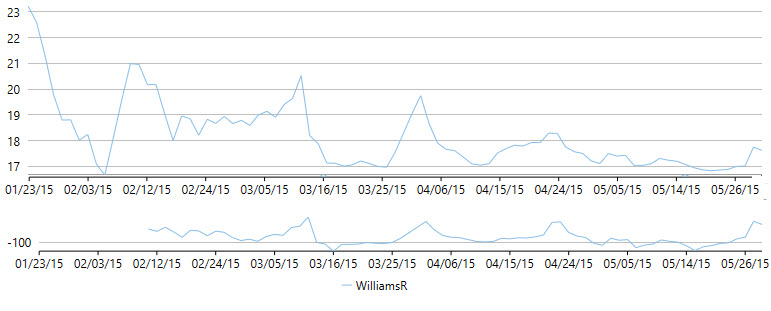Williams %R
Williams %R indicator for the FinancialChart is a momentum indicator, which compares the current asset price to the highest price over the look back period. Its look-back is typically 14 periods. The indicator fluctuates between 0 and -100. It is the inverse of a fast Stochastic Oscillator.
While the Williams %R displays the level of a stock's close relative to the highest high for the look-back period, the Stochastic Oscillator shows the level of a stock's close relative to the lowest low. Both the indicators show same lines, however scaling is different. It finds application in determining Overbought/Oversold levels, providing buy and sell signals, and momentum confirmations.
To work with WilliamsR indicator, you need to create an instance of WilliamsR class. FinancialChart also enables you to fetch the calculated WilliamsR values at run-time using GetValues() method. This can help in creating alerts in application or maintaining logs while working with dynamic data.
The following code snippet demonstrates how to use the indicator.
Partial Public Class Indicators
Inherits UserControl
Private dataService As DataService = dataService.GetService()
Private wr As New WilliamsR() With {
Key.SeriesName = "WilliamsR"
}
Public Sub New()
InitializeComponent()
End Sub
Public ReadOnly Property Data() As List(Of Quote)
Get
Return dataService.GetSymbolData("box")
End Get
End Property
Public ReadOnly Property IndicatorType() As List(Of String)
Get
Return New List(Of String)() From {
"Williams %R"
}
End Get
End Property
Private Sub OnIndicatorTypeSelectionChanged(sender As Object, e As SelectionChangedEventArgs)
Dim ser As FinancialSeries = Nothing
If cbIndicatorType.SelectedIndex = 0 Then
ser = wr
End If
If ser IsNot Nothing AndAlso Not indicatorChart.Series.Contains(ser) Then
indicatorChart.BeginUpdate()
indicatorChart.Series.Clear()
indicatorChart.Series.Add(ser)
indicatorChart.EndUpdate()
End If
End Sub
Private Sub OnFinancialChartRendered(sender As Object, e As C1.WPF.Chart.RenderEventArgs)
If indicatorChart IsNot Nothing Then
indicatorChart.AxisX.Min = DirectCast(financialChart.AxisX, IAxis).GetMin()
indicatorChart.AxisX.Max = DirectCast(financialChart.AxisX, IAxis).GetMax()
End If
End Sub
End Classpublic partial class Indicators : UserControl
{
DataService dataService = DataService.GetService();
WilliamsR wr = new WilliamsR() { SeriesName = "WilliamsR" };
public Indicators()
{
InitializeComponent();
}
public List<Quote> Data
{
get
{
return dataService.GetSymbolData("box");
}
}
public List<string> IndicatorType
{
get
{
return new List<string>()
{
"Williams %R"
};
}
}
void OnIndicatorTypeSelectionChanged(object sender, SelectionChangedEventArgs e)
{
FinancialSeries ser = null;
if (cbIndicatorType.SelectedIndex == 0)
ser = wr;
if (ser != null && !indicatorChart.Series.Contains(ser))
{
indicatorChart.BeginUpdate();
indicatorChart.Series.Clear();
indicatorChart.Series.Add(ser);
indicatorChart.EndUpdate();
}
}
void OnFinancialChartRendered(object sender, C1.WPF.Chart.RenderEventArgs e)
{
if (indicatorChart != null)
{
indicatorChart.AxisX.Min = ((IAxis)financialChart.AxisX).GetMin();
indicatorChart.AxisX.Max = ((IAxis)financialChart.AxisX).GetMax();
}
}
}


